The schwerer Panzerspähwagen (Fu) Sd.Kfz. 232 (8-rad) (Sonderkraftfahrzeug 232) was produced from 1938 to 1943 and carried a Fu.Ger.11 SE 100 medium range and a Fu.Spr.Ger.A short range radio. It was armed with a 2 cm KwK 30 L/55 autocannon and a coaxial 7.92 mm MG 34 machine gun. It had 8 wheel drive, 8 wheel steering with a driver position on both ends. The front armour was 15 mm of slightly sloped homogeneous steel with 8 mm on the sides, 10 mm on the back, 6 mm on top and 5 mm on the bottom. Its armour only provided protection from small arms fire and HE fragments whereas it was ineffective against heavier weapons. Its operational range was 300 km (186 miles) and the max speed was 85 km/h (53 mph). The Sd.Kfz. 231 (8-rad) was the same as the Sd.Kfz. 232 but without the additional radios and the large antenna and were built from 1937 to 1941. The German Army used theses armoured cars for traditional cavalry missions for reconnaissance throughout the war in many campaigns and theaters.
This Tamyia 1/48 kit has two interesting marking options.
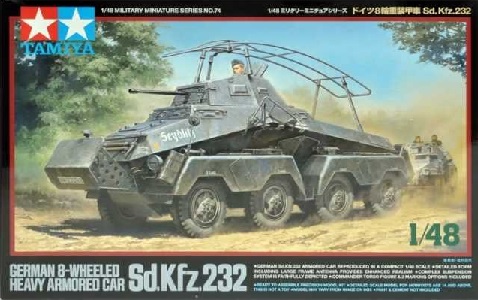
FIRST MARKING OPTION
“Seydlitz” WH-230748, 2nd kompanie, Aufklärungs-Abteilung 8, 5th Panzer-Division, Greece, April 1941
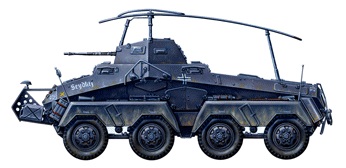
This armoured car was named after Prussian cavalry Generalleutnant Friedrich Wilhelm Freiherr von Seydlitz (3 February 1721 to 8 November 1773).
The 5th Panzer Division was sent to Romania and Bulgaria in early 1941 and took part in the invasion of Yugoslavia. After the Yugoslavia campaign, it was transferred from the First Panzer Group to the XL Panzer Corps which composed of the 1st SS LAH Motorized Infanterie Regiment, 73rd Infanterie Division and the 9th Panzer Division. On 15 April 1941 , the 5th Panzer Division started north of the Aliakmon and drove southward through Kalabaka toward the city of Lamia. They encountered road blocks, demolitions, and a number of minor engagements with commonwealth rear guards. On 20 April, Lamia was seized against minor resistance and the allies had withdrew south of Lamia to the Thermopylae line. The German supply situation was improved by the capture of rations and fuel stocks in the Lamia area. By 22 April, a column of the 5th Panzer Division attacked the Thermopylae positions that were defended by rear guard infantry supported by well-camouflaged artillery and individual tanks. After a strong resistance, the commonwealth troops abandoned Thermopylae Pass during the night of April 24-25. By April 30, the last commonwealth troops had either escaped or been taken prisoner and hostilities in Greece had ended.


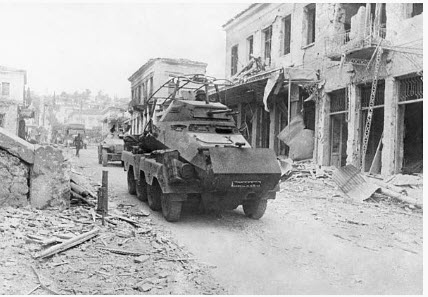

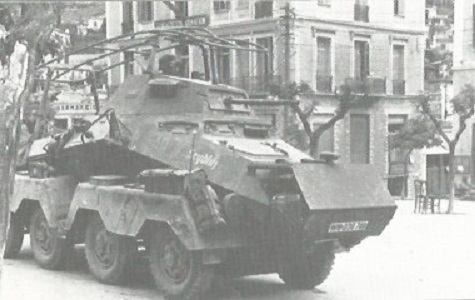
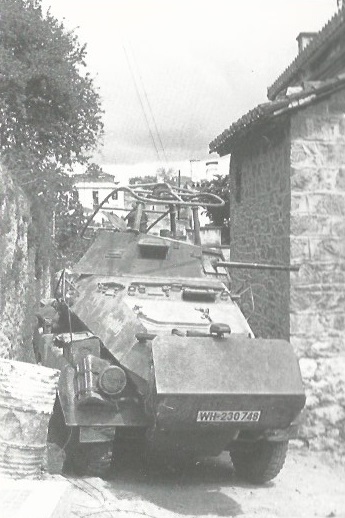
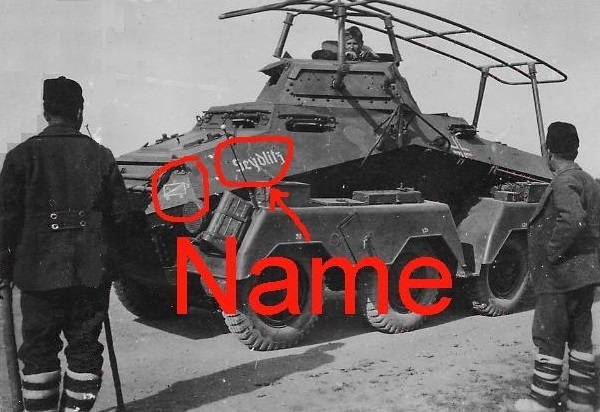
These films show Seydlitz passing through Lamia.
Greek Film: 1941-Occupation of Lamia by the Germans
This Sd.Kfz. 231 is from the same unit. Not able to make out the name on the hull side.
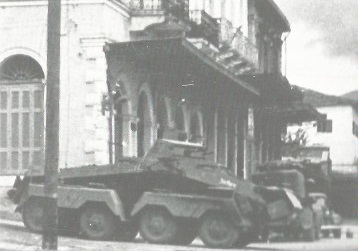
Commonwealth units in Greece 1941
‘W’ Force commanded by Lt Gen Sir Henry Maitland Wilson
– 6th Australian Division
– 2nd New Zealand Division
– British 1st Armoured Brigade
(102 RHA, 2 RHA, 3 RTR and 4 Hussars of the 2nd Armoured Division)
– Number of support units.
This Sd.Kfz. 232 is either from the 5th or 9th Panzer Division. The truck in the foreground is a Canadian Ford F60 L. 4×4 Artillery Tractor with markings of the British 2nd Armoured Division (1st Armoured Brigade).

SECOND MARKING OPTION
WH-612119, 1st kompanie, Aufklärungs-Abteilung 19, 19th Panzer-Division, Belgorod-Khar’kov, July-August 1943

During Unternehmen Zitadelle (Operation Citadel), the 19th Panzer Division belonged to the III Panzer Corps along with the 168th Infanterie, 6th and 7th Panzer Divisions. The III Panzer corps was positioned on the west bank of the Northern Donets River south of Belgorod with the 6th Panzer Division just south of Belgorod then the 19th and 7th Panzer Divisions. Across the river opposing the 19th PD was the Soviet 78th Guards Rifle Division. On 5 July 1943 (First day of Citadel), the 19th Panzer Division struck the 78th positions between Dalni Peski and DorogoBuzhino. The next three days, the 19th Panzer Division encountered heavy fighting and took heavy losses where it was only able to penetrate the furthest about 9 km (5.5 miles) into the soviet defensive line. The overall German advance slowed down and ultimately created conditions which prevented the timely linkup of the III Panzer Corps with the II SS Panzer Corps in the Prokhorovka area and caused Operation Citadel to fail. On August 3rd, the Soviet launched their strategic summer counter-offensive Operation Polkovodets Rumyantsev (the Germans called it “The Fourth battle of Kharkov” or the Belgorod-Kharkov Offensive) and by the end of August Belgorod and Kharkov (now Kharkiv) were recaptured and the German 4th Panzer Army (which includes the III Panzer Corps) was destroyed. The 36th Guards Heavy Breakthrough Tank Regiment, 18th Tank Corps, 5th Guards Tank Army was formed in March 1943 with some 31 to 35 Lend-lease Churchill IV tanks and was in the second echelon at the Battle of Prokhorovka which was assigned to infantry support. This is probably a 36th Guards Churchill passing the Sd.Kfz. 232. The car was probably disabled by strafing soviet ground-attack planes and abandoned.

This is my close up of the Sd.Kfz. 232 turret. Do not know what the purpose of the horizontal bar mounted on the antenna supports.

This is my close up of the zusatzfrontplatte (“Additional front panel”). Some sources captioned this Sd.Kfz. 232 as belonging to the 7th Panzer Division or the 2nd SS Panzer Division. Note that part of the camouflage pattern on the zusatzfrontplatte does look like a large number “7”. The twin vertical bars is the special Kursk marking used by the 19th Panzer Division during and immediately after Operation Citadel.
Here is a list of the special German Kursk Unit Markings
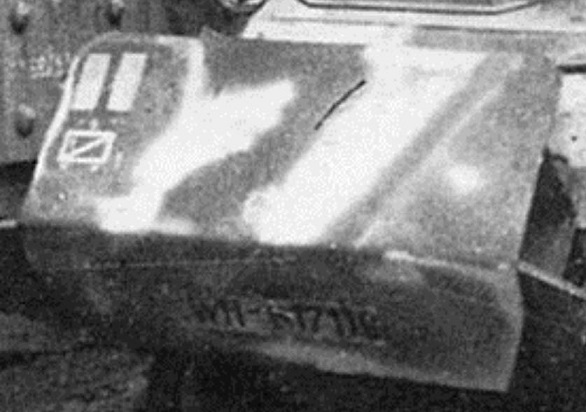
Another Churchill passing the same Sd.Kfz. 232 and the photo was taken from a slightly different angle.
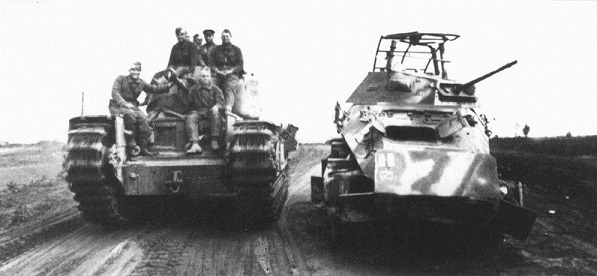
1st SS Leibstandarte AH 1939-1941
The Leibstandarte Panzerspähzug had four Sd.Kfz. 221s, two Sd.Kfz. 231s and two Sd.Kfz. 232s at the outset of the war. On the very first day of combat (1 September 1939), one each of the 231s and 232s were knocked out in Pabjanice, Poland.
Sd.Kfz. 221: SS-1084, SS-1085, SS-1086, SS-1087
Sd.Kfz. 231: SS-1088 “Körner II”
(replacement for “Körner” lost on the first day of combat in Poland)
Sd.Kfz. 231: SS-1089 “Laforce”
(original vehicle from 1937)
Sd.Kfz. 232: SS-1090 “Faust II”
(replacement for “Faust” also lost on the first day of combat in Poland)
Sd.Kfz. 232: SS-1091 “Casella”
(original vehicle from 1937)
“Faust” was totally burnt out after receiving a shot in the petrol tank after it ricocheted off the road and hit the under belly. The vehicle was either replaced or totally refurbished and was renamed “Faust II” which in turn was later knocked out in Russia, 1941.
The 8-rad armoured cars were named after the 16 men who died in Hitler’s failed Beer Hall putsch, 8–9 November 1923.
ALFARTH, BAURIEDL, CASELLA, EHRLICH, FAUST, HECHENBERGER, KÖRNER, KUHN, LAFORCE, NEUBAUER, PAPE, PFORDTEN, RICKMERS, SCHEUBNER-RICHTER, STRANSKY, WOLF
Here is “Laforce” seen on parade through Prague, Czechoslovakia on 5 October 1939. The center of the Balkenkreuz (crosses) were painted out leaving a white outline which was done during the Polish campaign.

This is “Laforce” in France 1940 about to tow a log.

This is my close up of the nearest license plate which barely shows the number 1089.
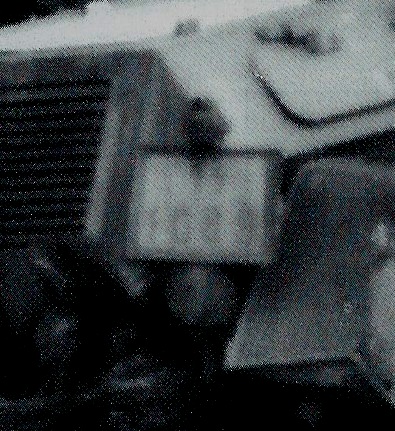
This is the front of “Laforce”. The triangular objects on the front fenders were 15 liter Kraftstoff Explosionssicher (explosion-proof fuel containers).
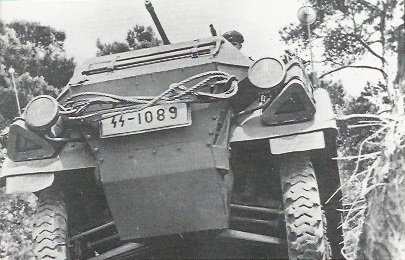
SS-1089 “Laforce” and SS-1091 in Greece April 1941.
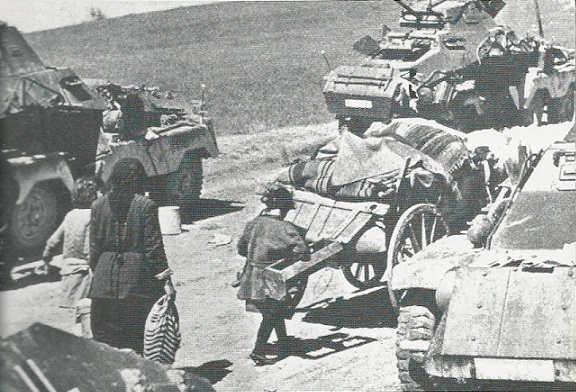
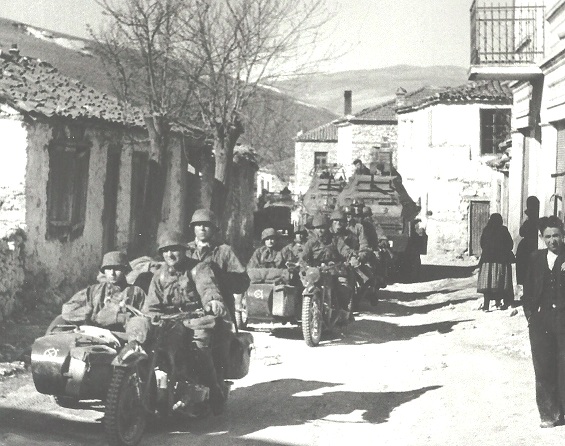
SS-1091 in a column in Poland.
Note the white cross on the bow has been painted over the tools.

Rear view of SS-1091 in Poland.
Note the “SS” on the license plates have been painted over.

Front view of SS-1091 in the Balkans 1941 (probably Greece) from a film.
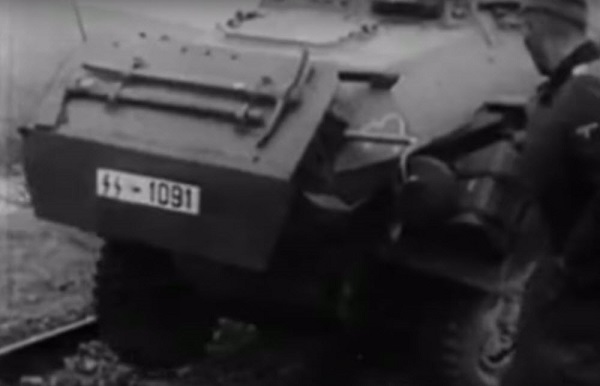
Sd.Kfz. 231, North Africa
March – April 1941
Note the British helmet on the zusatzfrontplatte and the pennant on the antenna.
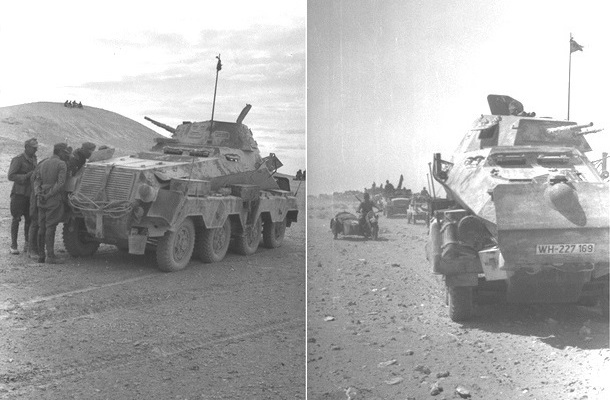


This field modified Sd.Kfz. 231 had the turret removed and a 5 cm Pak 38 AT gun was mounted.
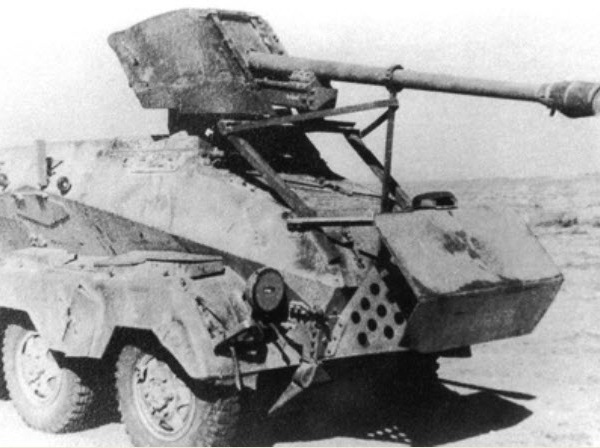
Sd.Kfz. 231 and Sd.Kfz. 232 of an unknown unit in France 1940.

My guess they have a smoke grenade rack mounted on the front bow. Note the horseshoe mounted next to the driver vision port and the wood bundle stuck in the Kraftstoff Explosionssicher rack on the front fender.
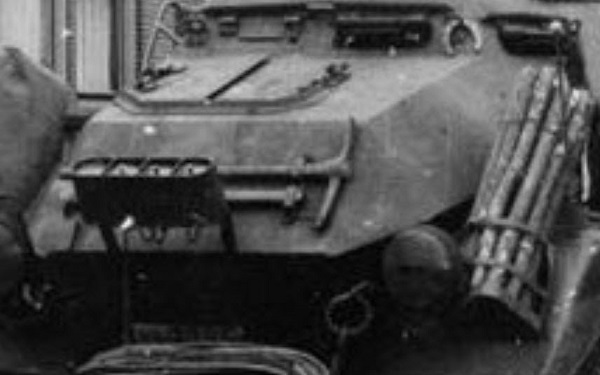
Where did I leave my armored car last night?
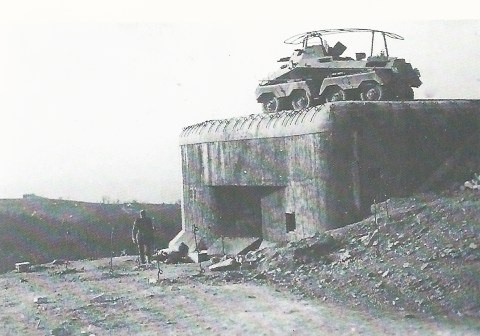
AFTER MARKET ACCESSORIES AVAILABLE
Hauler CZ: HLX48336 Sd.Kfz.232 Ger.Armored Car-basic (Tamiya)
Hauler CZ: HLX48337 Sd.Kfz.232 exhaust shroud mesh and silencer
Hauler CZ: HLX48338 Sd.Kfz.232 front bumper/spoiler
RB Models: 48B50 2cm KwK 30 L/55 Panzerkampfwagen II, SdKfz 231, 232
Toro-Model: 48022 – Sd.Kfz.231/232 – Polish campaign
Toro-Model: 48D14 – German armoured cars in Poland – September 1939
48022 is the Engine rear shutter without spare wheel mount conversion set an and 48D14 is their decal set which contains markings for SS-1089 “Laforce” and SS-1091. They incorrectly labeled “Laforce” as belonging to the “Das Reich” SS-Div.

Just found your blog….as a WW2 amateur historian and avid reader it is really awesome stuff! Thanks!
LikeLike
Your site has excellent content. I bookmarked the website
LikeLike
I’m so happy to read this. This is the kind of manual that needs to be given and not the accidental misinformation that is at the other blogs. Appreciate your sharing this greatest doc.
LikeLike
We stumbled over here coming from a different page and thought
I might as well check things out. I like what I see so now i’m following you.
Look forward to looking over your web page for a second
time.
LikeLike
I’m amazed, I have to admit. Rarely do I come across a blog that’s
both educative and entertaining, and without a doubt, you’ve hit the nail on the head.
The issue is an issue that not enough people are speaking intelligently
about. I am very happy that I found this in my hunt for something regarding this.
LikeLike
Oh my goodness! Incredible article dude! Many thanks, However I
am encountering problems with your RSS. I don’t know the
reason why I cannot subscribe to it. Is there anybody getting the same RSS problems?
Anyone that knows the solution will you kindly respond?
Thanks!!
LikeLike
Wow, great blog article.Much thanks again. Want more.
LikeLike
Unquestionably imagine that which you said. Your favorite reason seemed to be on the internet the easiest thing to understand of. I say to you, I definitely get annoyed while other folks think about worries that they just do not recognize about. You controlled to hit the nail upon the highest as smartly as outlined out the entire thing without having side-effects , people can take a signal. Will likely be again to get more. Thanks
LikeLike
Awesome post.
LikeLike
Great article! That is the kind of information that are supposed to be shared across the web.
Disgrace on the search engines for no longer positioning this post higher!
LikeLike
Good day! I could have sworn I’ve been to this blog before but after looking at some of the posts I realized it’s new to me.
Anyhow, I’m definitely pleased I came across it and I’ll be bookmarking it and checking back often!
LikeLike
Awesome post.
LikeLike
you’re really a just right webmaster. The web site loading speed is incredible.
It seems that you are doing any unique trick. Furthermore, The
contents are masterpiece. you have done a great activity on this matter!
LikeLike
Keep on writing, great job!
LikeLike
Thx for the insightful information
LikeLike